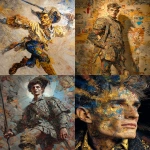Explore the Best AI Image Gallery

Beyond the Brushstrokes: Wearable Techs Transformative Touch on Creativity
The landscape of creativity is continuously evolving, driven by technological advancements that empower artists and designers to push boundaries. Among these innovations, wearable technology stands out as a transformative force, offering unprecedented opportunities for artistic expression, interactive experiences, and collaborative creations.
A New Canvas: Wearable Tech as an Artistic Tool
Wearable devices are blurring the lines between technology and art, providing artists with innovative tools to translate their visions into reality.
- Interactive Installations: Imagine sensors embedded in clothing that respond to the wearers movements, generating light patterns or soundscapes, transforming an entire space into a dynamic artwork.
- Gesture-Based Painting: Wearable interfaces allow artists to control digital brushes with hand gestures, creating fluid and expressive strokes on virtual canvases.
- Augmented Reality (AR) Experiences: AR glasses or contact lenses can overlay digital elements onto the physical world, enabling artists to create immersive installations that blend reality and fantasy.
Beyond Aesthetics: The Impact on Design and Collaboration
Wearable tech is not just changing how we create art; its also revolutionizing design processes and fostering collaboration.
- Product Prototyping: Designers can use haptic feedback from wearable sensors to test the ergonomics and functionality of products in real-time, refining their designs based on user experience.
- Remote Collaboration: Wearable devices facilitate collaboration between designers and engineers across geographical boundaries. Real-time data sharing and interactive design reviews bridge distances, streamlining the creative process.
Ethical Considerations: Navigating Uncharted Territory
As wearable tech becomes increasingly integrated into creative practices, it raises important ethical considerations that need careful attention:
- Privacy Concerns: Wearables collect vast amounts of data about users movements, interactions, and even biometric information. Ensuring responsible data collection, storage, and usage is crucial to protect user privacy.
- Accessibility and Inclusivity: Its essential that wearable tech empowers all creators, regardless of their physical abilities or socioeconomic backgrounds. Designing accessible and inclusive devices will ensure that everyone can benefit from these advancements.
- Bias and Representation: AI algorithms used in creative applications powered by wearable data can perpetuate existing biases if not carefully developed and monitored. Addressing algorithmic bias is crucial to promote fairness and diversity in creative outputs.
Future Horizons: The Convergence of Creativity and Technology
The future of creativity lies at the intersection of technology and human ingenuity. Wearable tech will continue to evolve, pushing the boundaries of artistic expression and design innovation:
- Brain-Computer Interfaces (BCIs): Imagine translating brainwaves into art, allowing artists to create directly from their thoughts.
- Personalized Creative Experiences: Wearables will enable tailored creative experiences based on individual preferences and skill levels, making art creation more accessible and engaging for everyone.
- The Metaverse and Beyond: Wearable technology will play a key role in shaping the metaverse, providing immersive and interactive creative environments where users can collaborate, share ideas, and build virtual worlds.
Conclusion
Wearable technology is not merely a tool; its a catalyst for transformative change in the creative landscape. By embracing its potential while addressing ethical considerations, we can unlock new frontiers of artistic expression, design innovation, and collaborative creativity. The future of art is wearable, interactive, and boundless.
](https://images.ai-img.art/thumbnails/150/3a60737a5b67fa252207ad1ae6db245a26284f53fb5846996bb34515b39ff269.webp)








](https://images.ai-img.art/thumbnails/150/1614d64dd7156c95db952258978be809eb3db8cea4453fec69c49cbdfe63fa94.webp)
](https://images.ai-img.art/thumbnails/150/8c3bd422d50d35735d8fb33bd314a79e30e5b150129d5d09bdad822a2007593f.webp)

